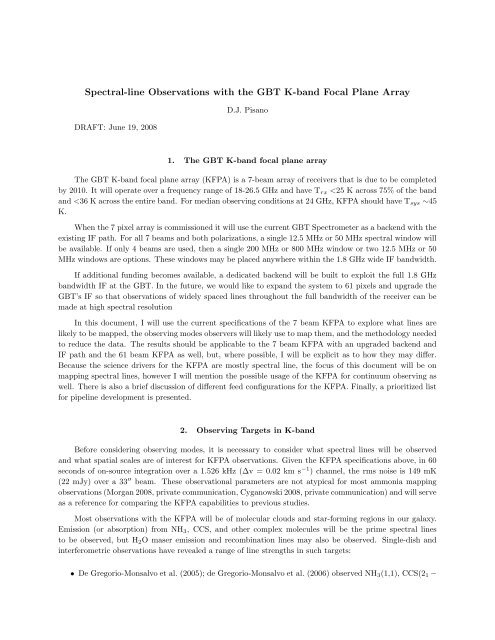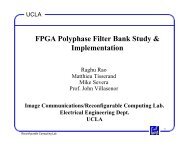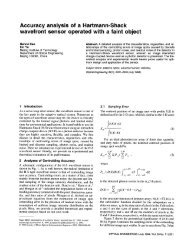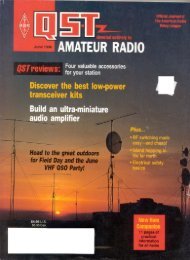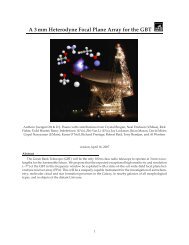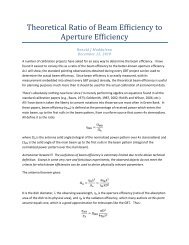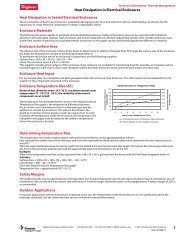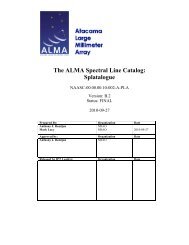Spectral-line Observations with the GBT K-band Focal Plane Array
Spectral-line Observations with the GBT K-band Focal Plane Array
Spectral-line Observations with the GBT K-band Focal Plane Array
You also want an ePaper? Increase the reach of your titles
YUMPU automatically turns print PDFs into web optimized ePapers that Google loves.
<strong>Spectral</strong>-<strong>line</strong> <strong>Observations</strong> <strong>with</strong> <strong>the</strong> <strong>GBT</strong> K-<strong>band</strong> <strong>Focal</strong> <strong>Plane</strong> <strong>Array</strong><br />
DRAFT: June 19, 2008<br />
D.J. Pisano<br />
1. The <strong>GBT</strong> K-<strong>band</strong> focal plane array<br />
The <strong>GBT</strong> K-<strong>band</strong> focal plane array (KFPA) is a 7-beam array of receivers that is due to be completed<br />
by 2010. It will operate over a frequency range of 18-26.5 GHz and have T rx
– 2 –<br />
1 0 ), and H 2 O masers in <strong>the</strong> star-forming region B1-IRS. They found maser emission peaking at ∼15<br />
mJy (although previous epochs had emission 100 times brighter). The NH 3 (1,1) emission peaks at<br />
T MB ∼4 K for <strong>the</strong> main <strong>line</strong> and ∼1 K for <strong>the</strong> satellite <strong>line</strong>s. CCS peaks at ∼0.7 K.<br />
• Kaifu et al. (2004) surveyed TMC-1 using <strong>the</strong> 45-m Nobeyama telescope. They found <strong>line</strong>s of HC 3 N,<br />
c-C 3 H 2 , HC 5 N, C 4 H, HC 7 N, CCS, CCCS, and NH 3 that are all detectable <strong>with</strong> 60 seconds on-source.<br />
• Pillai et al. (2006) studied NH 3 (1,1) and (2,2) in nine infrared dark clouds. They found peak T MB<br />
values of 2-4 K for <strong>the</strong> main <strong>line</strong> of NH 3 (1,1) and 0.5-1 K for <strong>the</strong> hyperfine transitions. For <strong>the</strong> (2,2)<br />
transition, <strong>the</strong> peak T MB is ∼0.5-2 K. FWHM <strong>line</strong>widths were of order 1 km s −1 .<br />
• Rosolowsky et al. (2008) used <strong>the</strong> <strong>GBT</strong> to survey NH 3 (1,1), (2,2), and CCS in dense cores in <strong>the</strong> Perseus<br />
molecular cloud spanning a range of environments from clusters to isolated star-forming regions to nonstar-forming<br />
regions. T MB for NH 3 (1,1) ranges from ∼0.5 - 5 K, and ∼0.2-1 K for NH 3 (2,2). For CCS<br />
<strong>the</strong> peak T MB ranges from ∼0.1 - 1 K. For all <strong>line</strong>s σ v ∼0.2 km s −1 .<br />
• Bell et al. (1993) observed W51, a complex of molecular clouds and star-forming regions between 17.6-<br />
22.0 GHz <strong>with</strong> <strong>the</strong> Green Bank 140 ft telescope. The only <strong>line</strong>s <strong>the</strong>y identified <strong>with</strong> T A ≥0.1 K were<br />
hydrogen recombination <strong>line</strong>s, NH 3 (9,6), and C 3 H 2 .<br />
• Rathborne et al. (2008) observed NH 3 (1,1), (2,2), CCS, and HC 5 N(9,8) towards 46 dense cores in <strong>the</strong><br />
Pipe nebula <strong>with</strong> <strong>the</strong> <strong>GBT</strong> down to a 1σ rms of 0.01-0.07 K. Peak T ∗ A values for NH 3(1,1) ranged<br />
from 0.1-4 K <strong>with</strong> <strong>the</strong> satellite <strong>line</strong>s visible only in <strong>the</strong> brightest spectra. For NH 3 (2,2), T ∗ A ranged<br />
from 0.06-1.37 K. Velocity dispersions for NH 3 were about 0.1-0.2 km s −1 . CCS was detected from<br />
fewer cores, but was sometimes stronger than NH 3 (1,1). The peak T ∗ A ranged from 0.06-0.78 K. For<br />
HC 5 N(9,8), only 4 cores had detectable emission <strong>with</strong> 0.27-0.58 K peak T ∗ A .<br />
• Longmore et al. (2007) observed NH 3 (1,1), (2,2), (4,4), and (5,5) towards hot molecular cores <strong>with</strong><br />
methanol maser emission; <strong>the</strong> sites of massive star formation using <strong>the</strong> ATCA. NH 3 (1,1) <strong>line</strong>s had<br />
peak fluxes of 0.2-0.4 Jy, <strong>with</strong> <strong>the</strong> satellite <strong>line</strong>s at 0.1-0.2 Jy. The NH 3 (2,2) <strong>line</strong> generally peaked at<br />
0.05-0.1 Jy, and <strong>the</strong> NH 3 (4,4) and (5,5) <strong>line</strong>s peaked at 0.05-0.1 Jy.<br />
• <strong>GBT</strong> observations of SgrB2 (N-LMH) by Hollis et al. (<strong>GBT</strong>07A-051) show that this star-forming, giant<br />
molecular cloud complex has quite different emission ratios than o<strong>the</strong>r regions. For example, <strong>the</strong>y find<br />
that <strong>the</strong> main <strong>line</strong>s of NH 3 and CCS are in absorption instead of emission. O<strong>the</strong>r transitions of NH 3<br />
and o<strong>the</strong>r molecules (such as HC 3 N, HNCO, CH 3 OH, and OCS) are seen in emission and are easily<br />
bright enough to detect <strong>with</strong> <strong>the</strong> observing parameters above (Remijian 2008, private communication).<br />
Some observers may also use <strong>the</strong> <strong>GBT</strong> KFPA for extragalactic observations of NH 3 , H 2 O masers, or<br />
o<strong>the</strong>r <strong>line</strong>s. These may or may not involve mapping; here are a few examples:<br />
• Ott et al. (2005) used <strong>the</strong> ATCA to observe NH 3 (1,1), (2,2), (3,3), and (6,6) in <strong>the</strong> galaxy NGC 253.<br />
Peak fluxes ranged from 10 to 50 mJy over a 30 ′′ ×5 ′′ beam <strong>with</strong> a total FWHM <strong>line</strong>width of ∼200 km<br />
s −1 .<br />
• Braatz & Gugliucci (2008) used <strong>the</strong> <strong>GBT</strong> to search for water maser emission from <strong>the</strong> nuclei of nearby<br />
galaxies. Such emission was found in 8 galaxies ranging from 16-138 mJy. Hagiwara (2007) used <strong>the</strong><br />
VLA to search for low luminosity water masers from nearby star-forming galaxies. A number of masers<br />
<strong>with</strong> peak fluxes ∼50 mJy in M 82, M 51, and NGC 4051 (and <strong>the</strong>re are similar examples in o<strong>the</strong>r<br />
galaxies studied by o<strong>the</strong>r authors).
– 3 –<br />
The main benefit of <strong>the</strong> KFPA is its ability to map large areas of sky rapidly. Given <strong>the</strong> typical <strong>line</strong><br />
strengths listed above, <strong>the</strong> majority of <strong>the</strong> mapping <strong>with</strong> <strong>the</strong> KFPA will be done of star-forming regions and<br />
molecular clouds in <strong>the</strong> NH 3 (1,1) <strong>line</strong>. However, for some objects, NH 3 (2,2), CCS, or o<strong>the</strong>r, more complex<br />
molecules may be able to be mapped <strong>with</strong> integration times of 1-2 minutes per pixel. For this science, source<br />
sizes range from <strong>the</strong> <strong>GBT</strong> beamsize (33 ′′ ) to <strong>the</strong> entire Galactic plane (hundreds of square degrees). We<br />
expect that most mapping observations will be of individual star-forming cores and and infrared dark clouds<br />
(IRDCs) to complexes of <strong>the</strong>se objects. These complexes will range from a few to 10s of arcminutes in size<br />
(e.g. Pillai et al. 2006; Rosolowsky et al. 2008, ; Friesen et al. 2008, in preparation; Morgan et al. 2008, in<br />
preparation).<br />
For observations of NH 3 that seek to derive temperatures and densities of <strong>the</strong> molecular gas and search<br />
for signatures of inflow or outflow (e.g. Longmore et al. 2007), <strong>the</strong> high spectral resolution cited above are<br />
necessary for resolving <strong>the</strong> NH 3 <strong>line</strong>s. Some observations can use coarser spectral resolution, e.g. 6.1 kHz,<br />
where <strong>the</strong> <strong>line</strong>s do not need to be fully resolved.<br />
For chemistry surveys, <strong>the</strong> KFPA can still be used in a non-mapping mode (to be described below). For<br />
extragalactic targets, NH 3 will be detectable <strong>with</strong> much deeper observations, as will H 2 O maser emission.<br />
3. Possible KFPA observing modes<br />
There are a number of possible observing modes for <strong>the</strong> KFPA, but <strong>the</strong>y broadly break down into<br />
mapping and single-pointing modes. In general, existing Astrid scan types and <strong>GBT</strong>IDL reduction procedures<br />
should be sufficient for data acquisition and reduction. There are a number of features that could be added<br />
to existing routines, however, to improve observing efficiency and improve data quality. For example, RFI<br />
can be rejected automatically if all beams show a spike at <strong>the</strong> same time. Redundant observations of <strong>the</strong><br />
same sky position <strong>with</strong> multiple beams will also improve <strong>the</strong> quality of <strong>the</strong> final maps.<br />
3.1. Mapping <strong>with</strong> <strong>the</strong> KFPA<br />
3.1.1. On-<strong>the</strong>-fly mapping<br />
On-<strong>the</strong>-fly (OTF) mapping has become <strong>the</strong> standard method for mapping large areas of sky quickly and<br />
efficiently (e.g. Holland et al. 1999; Barnes et al. 2001; Jackson et al. 2006; Mangum et al. 2007). Because of<br />
<strong>the</strong> power of <strong>the</strong> KFPA to map large areas, this is likely to be <strong>the</strong> primary mode of operation for <strong>the</strong> KFPA<br />
and <strong>the</strong> most important mode for development of a pipe<strong>line</strong>.<br />
Independent of <strong>the</strong> feed configuration, <strong>the</strong> most common approach is to scan <strong>the</strong> array along <strong>line</strong>s of<br />
constant RA and Declination (Barnes et al. 2001) or Galactic latitude and longitude (Jackson et al. 2006)<br />
making a raster and, sometimes, a basket-weave map. Consecutive stripes of <strong>the</strong> map are offset at <strong>the</strong><br />
Nyquist spacing. OTF maps have to have some “OFF” position for calibration. This can be provided ei<strong>the</strong>r<br />
by a separate, distinct “OFF” position from <strong>the</strong> map (Jackson et al. 2006) or using <strong>line</strong>-free regions of <strong>the</strong><br />
map (Barnes et al. 2001) or, in <strong>the</strong> cases where emission fills <strong>the</strong> map (e.g. for Galactic HI), frequencyswitching<br />
is used (e.g. Lockman et al. 2008). For ammonia mapping, <strong>the</strong> emission will generally fill <strong>the</strong> map,<br />
so frequency-switching will be used. For o<strong>the</strong>r molecules a dedicated “OFF” position or <strong>the</strong> blank areas of<br />
<strong>the</strong> map can be used. O<strong>the</strong>r scanning patterns may be more efficient in terms of overheads, for example<br />
MUSTANG uses a “billiard ball” trajectory, but <strong>the</strong> basic approach for reduction is independent of <strong>the</strong> exact
– 4 –<br />
trajectory used. I will explore alternative trajectories and <strong>the</strong>ir associated mapping efficiency in a future<br />
memo.<br />
For <strong>the</strong> KFPA on <strong>the</strong> <strong>GBT</strong>, we can use existing mapping procedures present in Astrid: RALongMap,<br />
RALongMapWithReference, DecLatMap and DecLatMapWithReference. Because we can not rotate <strong>the</strong><br />
KFPA feed pattern, observers will want to map <strong>the</strong> region of interest by Nyquist sampling <strong>with</strong> each beam<br />
of <strong>the</strong> array. This has <strong>the</strong> drawback of providing a reduced sensitivity border around <strong>the</strong> object being<br />
mapped and higher overhead. This region could be used to improve <strong>the</strong> calibration of <strong>the</strong> map, however.<br />
For frequency-switched data and if <strong>the</strong> noise diode is fired while scanning, <strong>the</strong>n <strong>the</strong> data rate will have to be<br />
higher so that all phases of switching sample closely <strong>the</strong> same position on <strong>the</strong> sky (<strong>with</strong>in a fraction of <strong>the</strong><br />
beamwidth).<br />
For reducing OTF data, <strong>the</strong> <strong>GBT</strong>IDL routines also already exist to reduce most of this data. For<br />
frequency-switched data, each beam and polarization can be separately reduced using getfs. For data taken<br />
<strong>with</strong> an “OFF” position, <strong>the</strong>n getps or getsigref can be used. It is only <strong>the</strong> scenario where an observer wishes<br />
to use <strong>the</strong> <strong>line</strong>-free portion of <strong>the</strong> map as an “OFF” position that <strong>GBT</strong>IDL can not currently handle <strong>the</strong><br />
calibration. This approach was used by HIPASS (Barnes et al. 2001) and o<strong>the</strong>r surveys using <strong>the</strong> Parkes<br />
20cm multibeam (e.g. Pisano et al. 2007) as well as <strong>the</strong> ALFALFA survey (Giovanelli et al. 2005), although<br />
<strong>the</strong> details on <strong>the</strong> reduction are not yet published]giovanelli05. So <strong>the</strong> calibration and <strong>band</strong>pass correction<br />
should not require any new algorithm development.<br />
There are many algorithms available for gridding OTF data. Currently for <strong>GBT</strong> observations, <strong>GBT</strong>IDL<br />
is used for <strong>the</strong> calibration and <strong>band</strong>pass calibration and <strong>the</strong>n <strong>the</strong> data is exported to AIPS where <strong>the</strong> task<br />
SDGRD is used to make an image. For Parkes and some ALFA data, livedata and gridzilla are used.<br />
The data rate for OTF mapping <strong>with</strong> <strong>the</strong> 7-pixel KFPA will require dumping 14 samples (7 beams,<br />
2 polarizations) for each phase of a frequency-switch and of <strong>the</strong> noise diode firing. For a 33 ′′ beam, that<br />
means we will need to dump every 13 ′′ . For <strong>the</strong> <strong>GBT</strong> Spectrometer, we can switch at a maximum rate of<br />
95 Hz for 4 phase switching (cal on and cal off for signal and reference frequencies) and <strong>with</strong> a minimum<br />
hardware-limited dump time 1 of 1.44 seconds to a local disk (although typical dump times are ∼2 seconds<br />
for an NFS-mounted disk). Since <strong>the</strong> minimum dump time is only 40% less than <strong>the</strong> typical dump time, we<br />
will just consider <strong>the</strong> latter. A 2 second dump time yields a scanning rate of 6.5 ′′ s −1 . These rates are much<br />
less than <strong>the</strong> slew speed, so we will not run into any hardware limits for mapping.<br />
If we have ei<strong>the</strong>r 12.5 MHz or 50 MHz <strong>band</strong>widths, <strong>the</strong>n we will have no more than 16384 channels per<br />
sampler (for 3 level sampling). With only 4 phases per integration, <strong>the</strong>n we will have 65 kB per integration.<br />
For a 2 second integration, this is 1.8 MB/s. Using <strong>the</strong> minimum dump time, <strong>the</strong> data rate is 40% higher.<br />
If <strong>the</strong> noise diode is not fired during <strong>the</strong> mapping observations or frequency-switching is not used, <strong>the</strong>n<br />
<strong>the</strong> data rates would be halved. If, however, <strong>the</strong> switching rate is increased, <strong>the</strong>n <strong>the</strong> data rate would be<br />
proportionally higher. A new backend that can fully sample <strong>the</strong> 1.8 GHz IF <strong>band</strong>width will have a data rate<br />
that is no more than 144 times (1.8 GHz/12.5 MHz) higher for <strong>the</strong> same spectral resolution. For increased<br />
spectral resolution, <strong>the</strong> data rate will increase proportionally. For a 61-pixel array, <strong>the</strong> data rate would<br />
increase by ano<strong>the</strong>r factor of 9. Finally, if <strong>the</strong> entire receiver <strong>band</strong>width is sampled, <strong>the</strong>n <strong>the</strong> data rate is no<br />
more than 576 times higher (8 GHz/12.5 MHz) for <strong>the</strong> same spectral resolution. All told, this could result<br />
in data rates for a 61-pixel FPA sampling <strong>the</strong> full 8 GHz <strong>band</strong>width of ∼10 GB/s. While all of this data<br />
need not be saved on disk, it is still beyond our current capabilities.<br />
1 The minimum dump time for <strong>the</strong> Spectrometer is 0.09× N phases × N quadrants .
– 5 –<br />
For a map size of 3 ′ ×3 ′ (26 beams) <strong>with</strong> a total integration time of 1 minute per beam, <strong>the</strong> 7-pixel<br />
KPFA will produce 406 MB of data <strong>with</strong> 2 second integrations. If <strong>the</strong> map is of a typical IRDC (about<br />
12 ′ ×12 ′ in size), <strong>the</strong>n a total of 6.5 GB of data will contribute to a map.<br />
3.1.2. Jiggle mapping<br />
For mapping sources smaller than <strong>the</strong> array, we can ei<strong>the</strong>r do a very small OTF map using <strong>the</strong> same<br />
approach as described above, or we can use a jiggle map similar to <strong>the</strong> technique used by SCUBA (Holland<br />
et al. 1999). For a single SCUBA array, <strong>the</strong>re is a 16 point pattern that <strong>the</strong> array is cycled through. Each<br />
point is offset by half a beamwidth from <strong>the</strong> neighboring point. For SCUBA, <strong>the</strong> telescope is nodded to an<br />
“OFF” position each cycle while chopping occurs throughout <strong>the</strong> observing. For <strong>the</strong> KFPA, <strong>the</strong> feed spacing<br />
is larger than for SCUBA so <strong>the</strong> equivalent pattern would have 36 pointings. Because <strong>the</strong> atmosphere is<br />
more stable at 22 GHz than at 450 µm, <strong>the</strong> “OFF” position would not need to be visited as often by KFPA<br />
as for SCUBA. If frequency-switching is used, <strong>the</strong>n no distinct “OFF” position would be needed.<br />
The weakest aspect of a jiggle map is that <strong>the</strong> <strong>GBT</strong> will have to slew and <strong>the</strong>n dwell at each position<br />
leading to larger overheads. This overhead could be reduced by using <strong>the</strong> subreflector to move between<br />
positions, but it will still be larger than for an OTF map. Using <strong>the</strong> subreflector for this motion would also<br />
limit <strong>the</strong> variations of <strong>the</strong> atmosphere between pointings. The 36 point cycle should be done on a short<br />
enough time period that field rotation is not large. This observing mode could be mimicked by an OTF map<br />
<strong>with</strong> an appropriate scanning rate.<br />
A jiggle map could be made using a simply modified form PointMap or PointMapWithReference. Reduction<br />
could be done in <strong>the</strong> same manner as for an OTF map.<br />
3.2. Single-pointing modes<br />
While mapping is likely to be <strong>the</strong> most common mode of observing for <strong>the</strong> KFPA, it is likely that <strong>the</strong><br />
performance of <strong>the</strong> array will be at least as good as <strong>the</strong> existing K-<strong>band</strong> receiver. Therefore, <strong>the</strong> KFPA may<br />
replace this receiver for observations of point sources as well. There are a number of observing modes that<br />
will be used for observing point sources <strong>with</strong> <strong>the</strong> KFPA.<br />
3.2.1. Traditional switching<br />
The KFPA will be able to use traditional observing modes, such as position-switching and frequencyswitching.<br />
This could be done using all 7 (or 61) beams or a subset of beams (1,2, or 4). Position-switching<br />
would be used for sources that are extended <strong>with</strong> respect to <strong>the</strong> array, but which <strong>the</strong> observer does not wish<br />
to map (for astrochemistry surveys, for example). Frequency-switching could be used for ei<strong>the</strong>r extended<br />
sources or point sources located in a single beam. Because of field rotation over time, <strong>the</strong> outer beams will<br />
smear into an annulus over time so minimal information will be available about <strong>the</strong> distribution of emission<br />
from a source.<br />
<strong>Observations</strong> would be carried out using standard Astrid scan types such as Track and OnOff (or OffOn)<br />
and reduction in <strong>GBT</strong>IDL such as getfs and getps.
– 6 –<br />
Single pixel operation will be possible for VLBI observing as well.<br />
3.2.2. “MX” mode<br />
For point-sources, an array provides a powerful mode for improving observing overhead and <strong>the</strong> signalto-noise<br />
delivered in a given amount of observing time as well as data quality. This mode has been used<br />
by <strong>the</strong> Parkes multibeam for point source observations and is called “MX” mode. It is a generalization of<br />
standard dual-beam, nodding observation as done currently at <strong>the</strong> <strong>GBT</strong>. For <strong>the</strong> 7-pixel KFPA, an observer<br />
would point each beam in turn at <strong>the</strong> source while <strong>the</strong> o<strong>the</strong>r beams observe an “OFF” position. This “OFF”<br />
position would be different for each beam and would rotate <strong>with</strong> time. Long dwell times for each beam are<br />
possible, but, in general, observers will want this to be reasonably short (of order one minute) to minimize<br />
rotation and variations in <strong>the</strong> atmosphere.<br />
This mode provides six times <strong>the</strong> integration time in <strong>the</strong> “OFF” position as in <strong>the</strong> “ON” position yielding<br />
improved signal-to-noise. Because “OFF” observations will generally bracket <strong>the</strong> “ON” observations, so <strong>the</strong><br />
background subtraction should also be improved. For <strong>the</strong> 61-pixel KFPA, it is likely that only a subset<br />
of beams would be used. Switching between beams could be done by slewing <strong>the</strong> telescope or tilting <strong>the</strong><br />
subreflector. To carry out <strong>the</strong>se observations generalized forms of <strong>the</strong> Nod and/or SubBeamNod procedures<br />
will need to be developed for multiple beam (greater than 2) receivers. To reduce <strong>the</strong> data, a change in<br />
labels will be needed for <strong>GBT</strong>IDL routines to cope <strong>with</strong> multiple “OFF” beams and positions. O<strong>the</strong>rwise,<br />
getnod or Ron Maddalena’s getSubrnod should be able to reduce <strong>the</strong> data <strong>with</strong> minimal changes.<br />
3.3. Continuum Observing<br />
There are plans to use <strong>the</strong> KFPA for continuum and polarization observations. While <strong>the</strong>se observing<br />
modes are not <strong>the</strong> primary science drivers, we expect that <strong>the</strong> KFPA will be used and be useful for this<br />
science. It is likely that continuum observing <strong>with</strong> <strong>the</strong> KFPA and subsequent data reduction will utilize a<br />
similar strategy as is used for <strong>the</strong> GALFACTS project <strong>with</strong> <strong>the</strong> ALFA multibeam.<br />
3.4. Feed Layout<br />
Some FPAs have been packed in a hexagonal configuration (like SCUBA, <strong>the</strong> Parkes multibeams, and<br />
ALFA), while o<strong>the</strong>r FPAs have been rectangularly packed (like SEQUOIA, BEARS, and HARP). Is <strong>the</strong>re a<br />
preferred configuration for <strong>the</strong> KFPA given its anticipated usage?<br />
A hexagonally packed array places <strong>the</strong> feeds as close toge<strong>the</strong>r as physically possible. For <strong>the</strong> KFPA,<br />
this corresponds to a 3 beamwidth spacing at 24 GHz. As such, this maximizes both <strong>the</strong> number of feeds<br />
we can fit in a dewar and <strong>the</strong> amount of area covered by <strong>the</strong> array in a single-pointing. The dense packing<br />
may make it more difficult to access <strong>the</strong> front-end electronics for maintenance, however this does not appear<br />
to be a concern for KFPA and is certainly not an issue for <strong>the</strong> 7-pixel array. Finally, <strong>with</strong> a hexagonally<br />
packed array <strong>the</strong> telescope can be scanned at an angle of 19 ◦ to any of <strong>the</strong> long axes of <strong>the</strong> array to produce<br />
tracks that are spaced at 1 beamwidth instead of <strong>the</strong> 3 beamwidth physical spacing for <strong>the</strong> KFPA. Since <strong>the</strong><br />
KFPA will not have a feed rotator, it will not be possible to scan at this angle most of <strong>the</strong> time, but we can<br />
scan at close to this angle <strong>with</strong> <strong>the</strong> correct array configuration. This is less important for <strong>the</strong> full 61-pixel
– 7 –<br />
array due to <strong>the</strong> redundancy of that configuration.<br />
A rectangular packed array is a simpler geometry and provides more room for access to front-end<br />
electronics. It is not as densely packed as a hexagonal configuration and <strong>the</strong>re is no magic scanning angle.<br />
This has not been a problem for o<strong>the</strong>r arrays, even those <strong>with</strong>out feed rotators (e.g. Jackson et al. 2006), but<br />
does require more rapid sampling when scanning. Clever scanning algorithms may also mitigate this problem.<br />
It is not evident, however, what advantages beyond simplicity a rectangularly packed array provides.<br />
3.5. Possible alterations to existing systems<br />
Is <strong>the</strong>re additional metadata needed to make data reduction possible or more efficient? Are <strong>the</strong>re any<br />
hardware-related upgrades that would be necessary or helpful? Finally, what additional features could be<br />
added to ASTRID, SDFITS, or <strong>GBT</strong>IDL that would exploit <strong>the</strong> multibeam nature of <strong>the</strong> KFPA? This<br />
section summarizes some of <strong>the</strong> answers to <strong>the</strong>se questions.<br />
Beyond <strong>the</strong> plans for a more detailed database for calibration (including vector T cal values, for example)<br />
and wea<strong>the</strong>r-related information (like <strong>the</strong> opacity), <strong>the</strong> main alteration of existing software will involve <strong>the</strong><br />
proper accounting of more than two beams. Currently, <strong>the</strong> SDFITS filler and <strong>GBT</strong>IDL can deal <strong>with</strong> simple<br />
position-switched and nodding data from dual beam receiver. However, having numerous beams (up to 61)<br />
requires keeping track of many “OFF” positions. If <strong>the</strong> subreflector is used to switch between beams, <strong>the</strong>n<br />
<strong>the</strong> current system of assigning a flag based on whe<strong>the</strong>r <strong>the</strong> subreflector is moving or aligned <strong>with</strong> beam 0<br />
or 1 will need to be expanded to cope <strong>with</strong> up to 61 beams. In addition, particularly for a 61 beam array,<br />
<strong>the</strong> aperture efficiency will vary between beams requiring different aperture efficiencies to be used for each<br />
beam.<br />
The above observing modes should be simple generalizations of current ASTRID scan types. New<br />
wrappers should probably be written to allow easier use of a OTF map or a jiggle map for <strong>the</strong> KFPA, but<br />
<strong>the</strong> current scan types should work. The “MX” mode will require a new scan type in ASTRID. It may<br />
exploit <strong>the</strong> subreflector, which can be done using <strong>the</strong> SubMotion object (or a variation on it).<br />
For <strong>GBT</strong>IDL, existing reduction algorithms should work for all observing modes, except for “MX” mode.<br />
For “MX” mode, <strong>the</strong>re will need to be an alteration to <strong>the</strong> code to average multiple “OFF” scans and use<br />
those for calibration and <strong>band</strong>pass correction. These scans could be combined ei<strong>the</strong>r <strong>with</strong> a straight average<br />
or some sort of median or minmax combination to mitigate RFI and cope <strong>with</strong> bad or missing integrations.<br />
The “MX” mode will be necessary for calibrating <strong>the</strong> array, since each beam will need to observe a known<br />
flux calibrator to derive vector T cal values.<br />
Currently, imaging for <strong>GBT</strong> mapping data is done via AIPS. This approach should still work for <strong>the</strong><br />
7-pixel KFPA if AIPS can cope <strong>with</strong> <strong>the</strong> data volume. The data volumes could be prohibitively large for<br />
this approach to work for <strong>the</strong> 61-pixel KFPA.<br />
There is currently no statistical flagging available in <strong>GBT</strong>IDL. The KFPA is well-suited to some simple<br />
flagging and calibration tasks that exploit <strong>the</strong> redundancy of a multibeam system. For example, if all beams<br />
experience a sudden change in <strong>the</strong>ir power levels, <strong>the</strong>n <strong>the</strong> source is likely to be RFI and is not astronomical.<br />
Additionally, atmospheric variations will be (mostly) common between beams and slowly varying. There are<br />
a number of instruments that exploit this information for improved atmospheric removal. For example, this<br />
is done <strong>with</strong> MUSTANG on <strong>the</strong> <strong>GBT</strong>. Finally, all beams should measure <strong>the</strong> same flux when observing <strong>the</strong><br />
same direction on <strong>the</strong> sky. This “basket-weaving” calibration can be used to improve <strong>the</strong> standard calibration
– 8 –<br />
as is being done for <strong>the</strong> GALFACTS observations. This is not a necessary step, but may improve <strong>the</strong> data<br />
quality for <strong>the</strong> KFPA. It may be particularly useful for removal of atmospheric variations.<br />
4. Summary of Pipe<strong>line</strong> Priorities<br />
What should <strong>the</strong> software priorities for pipe<strong>line</strong> development be? These have been discussed above, but<br />
in priority order <strong>the</strong>y are as follows:<br />
1. The proper accounting of multiple beams by ASTRID, SDFITS, and <strong>GBT</strong>IDL.<br />
2. The reduction and gridding of OTF data using existing <strong>GBT</strong>IDL routines.<br />
3. The observing and reduction of “MX”mode observations.<br />
4. Finally, <strong>the</strong> exploitation of multibeam observations for improved atmospheric removal, flagging, calibration<br />
and analysis of <strong>the</strong> data.<br />
In addition, development of continuum observing modes and data reduction is also necessary, but this<br />
effort will likely be led by our collaborators in Calgary.<br />
Thanks to Larry Morgan and Claudia Cyganowski for sharing <strong>the</strong>ir K-<strong>band</strong> observing experiences.<br />
Thanks to Ron Maddalena, Mark Clark, and Bob Garwood for help <strong>with</strong> <strong>the</strong> data rate calculations.<br />
Barnes, D. G., et al. 2001, MNRAS, 322, 486<br />
REFERENCES<br />
Bell, M. B., Avery, L. W., & Watson, J. K. G. 1993, ApJS, 86, 211<br />
Braatz, J. A., & Gugliucci, N. E. 2008, ApJ, 678, 96<br />
Giovanelli, R., et al. 2005, AJ, 130, 2598<br />
De Gregorio-Monsalvo, I., Chandler, C. J., Gómez, J. F., Kuiper, T. B. H., Torrelles, J. M., & Anglada, G.<br />
2005, ApJ, 628, 789<br />
de Gregorio-Monsalvo, I., Gómez, J. F., Suárez, O., Kuiper, T. B. H., Rodríguez, L. F., & Jiménez-Bailón,<br />
E. 2006, ApJ, 642, 319<br />
Hagiwara, Y. 2007, AJ, 133, 1176<br />
Holland, W. S., et al. 1999, MNRAS, 303, 659<br />
Jackson, J. M., et al. 2006, ApJS, 163, 145<br />
Kaifu, N., et al. 2004, PASJ, 56, 69<br />
Lockman, F. J., Benjamin, R. A., Heroux, A. J., & Langston, G. I. 2008, ApJ, 679, L21<br />
Longmore, S. N., Burton, M. G., Barnes, P. J., Wong, T., Purcell, C. R., & Ott, J. 2007, MNRAS, 379, 535
– 9 –<br />
Mangum, J. G., Emerson, D. T., & Greisen, E. W. 2007, A&A, 474, 679<br />
Ott, J., Weiss, A., Henkel, C., & Walter, F. 2005, ApJ, 629, 767<br />
Pillai, T., Wyrowski, F., Carey, S. J., & Menten, K. M. 2006, A&A, 450, 569<br />
Pisano, D. J., Barnes, D. G., Gibson, B. K., Staveley-Smith, L., Freeman, K. C., & Kilborn, V. A. 2007,<br />
ApJ, 662, 959<br />
Rathborne, J. M., Lada, C. J., Muench, A. A., Alves, J. F., & Lombardi, M. 2008, ApJS, 174, 396<br />
Rosolowsky, E. W., Pineda, J. E., Foster, J. B., Borkin, M. A., Kauffmann, J., Caselli, P., Myers, P. C., &<br />
Goodman, A. A. 2008, ApJS, 175, 509<br />
This preprint was prepared <strong>with</strong> <strong>the</strong> AAS LATEX macros v5.2.


